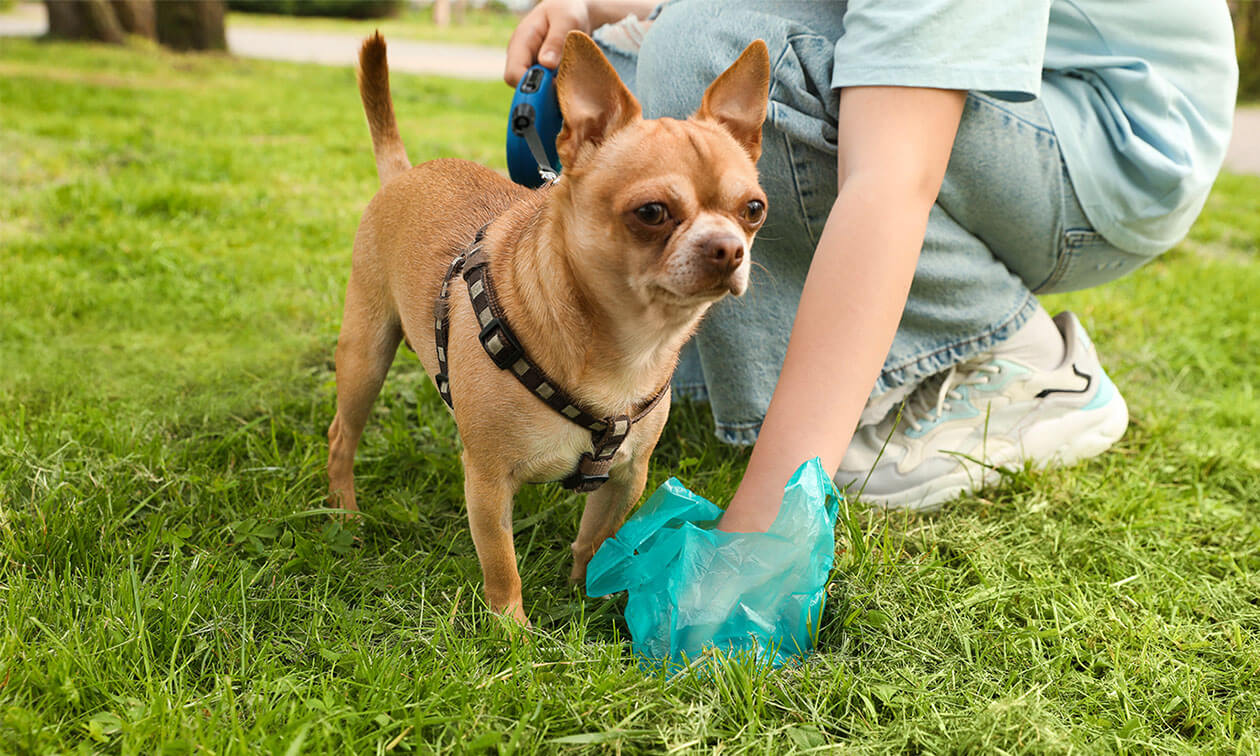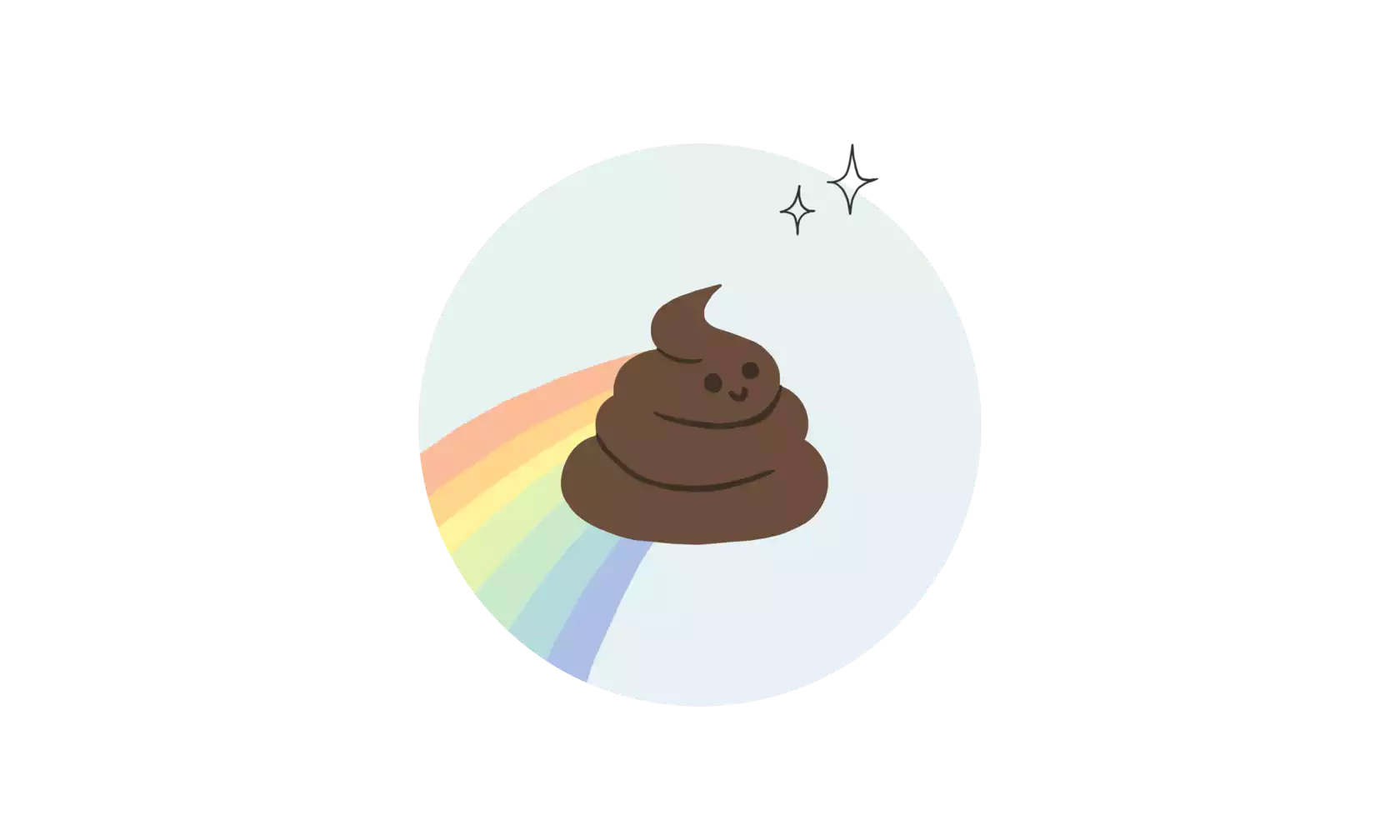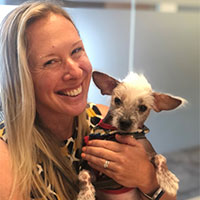While no one really likes to think about poop, it’s an important part of your dog’s health. Since dogs can’t tell us when they feel bad, changes in their poop can be a clue that they may be sick or feeling discomfort, and needing support from you and your veterinarian.
What’s “Normal” for Your Dog?
Every dog has a different baseline (or what we would consider normal). Every dog will have a baseline around the amount of times they poop every day, color and consistency of their poop. Factors that affect their poop include things like what type of food they eat, how much they eat and drink, sleep patterns, and even bowel movements.
Even if your dog has free range of the yard and you don’t always see them pooping, it’s a good idea to pick up their poop daily and try to watch them poop at least once a day to ensure that everything is coming out normally. This gives you a chance to collect a fresh poop sample and reach out to your veterinarian if you see anything out of the ordinary.
What Should Dog Poop Look Like?
Since every dog has a different baseline, their stool will all look a little different, too. That said, signs of healthy dog poop are similar in shape, color, and consistency for every dog. The size of healthy dog stool depends on the size of the dog. Signs of unhealthy dog poop, on the other hand, can vary.
Normal poop is chocolate brown, in the shape of a log. While there’s a bit of smell, it shouldn’t knock you over. When you pick it up, the poop holds its shape but isn’t hard. After removing the poop, there should be little or no poop residue visible on the ground.
Poop Consistency
Normal, healthy dog poop should be firm and hold its shape. When picked up, it doesn’t leave visible residue on the ground.
- Too hard. Poop that is too hard may come out in pebble form or as logs with cracks. Often if it’s hard, a dog will strain while defecating. This can indicate constipation. The most common causes of constipation are dehydration, intestinal blockage, pain in the anal region due to a mass or anal gland infection, or a neurological disorder.
- Too soft. There are many types of soft poop. It may come out still in log form but soft, looking like soft serve ice cream or resembling a cow patty (very wet poop with some texture). The most common causes of soft poop are infections, changes in diet, food allergies, inflammatory bowel disease, eating a toxin, and metabolic disorders.
- Loose and runny. Liquid dog poop is diarrhea. Common causes of diarrhea in dogs are similar to the causes of soft stool.
Poop Color
Normal dog poop is brown to dark brown. Diet plays a role in this color, so if you change your dog’s food or give them treats, it may look a little different from its normal shade. But if they color changes drastically, that can indicate a health issue.
- Red. Poop that is entirely red could be due to eating red food like beets. If your dog has not eaten red food, and especially if all or most of the poop looks like blood, see a veterinarian right away. Red poop can be seen with Acute Hemorrhagic Diarrhea Syndrome, Parvovirus, clotting disorders, or other serious diseases —these could be serious if left untreated.
- Black. Fresh poop that is black may mean bleeding in the gastrointestinal tract (mouth, esophagus, stomach, or upper small intestine). See a veterinarian right away, as this can lead to significant blood loss.
- Orange or yellow. These colors may indicate an issue with the liver or biliary system.
- Green or blue. Green or blue poop may be seen after a dog has eaten rat/mouse poison. If you or your neighbors have rat poison baits on your property, get your dog to a veterinarian as quickly as possible and find out which poison was used.
Blue poop may also be seen when a dog eats something blue, such as magic markers. Other potential causes of green poop include eating a lot of grass (sometimes you will see bits of grass in the poop) and gall bladder disease. - White, gray, or greasy. Dogs with white, gray, or greasy poop may have difficulty properly digesting food due to issues in the liver or pancreas.
- Red striping in the poop. Red on the poop or mixed with the mucus may be due to straining or an issue near the anus, such as an infected anal gland or mass.
Material in or on Dog Poop
- Mucus. Mucus is a normal lubricant that helps poop pass through the colon, and it occasionally appears on healthy poop. More mucus on hard poops and some soft poops can be a sign of dehydration or inflammation in the intestines.
- Hair. Dogs sometimes eat a bit of hair, and finding this in the poop occasionally is not a reason for concern. If you see hair routinely or find a lot of hair in the poop, causes could include allergies, anxiety, or a skin disorder.
- Foreign objects. If you find non-food objects in your dog’s poop, your next step is to check your dog for signs of illness or pain. Also, check your home for any remaining pieces of the object.
- White dots. White dots on or in the poop may be a sign of a tapeworm, bone fragments, or small white foreign objects that your dog has eaten.
- Worms. Worms, moving or dead, are signs that your pet is infected with parasites.
Poop Size and Frequency
Size and schedule of every dog’s bowel movement vary from dog to dog, but as a rule of thumb, small dogs have small feces and big dogs have big ones. A puppy has frequent bowel movements, between three to six a day, while a maturing dog tends to have one to three a day. Some dogs will spend a lot of time choosing the specific spot where they want to poop. But once they have a spot, passing that poop should go easily for your dog, with no straining.
Size
Diet can affect the size of your dog’s poops. A high fiber diet can make poops larger. Check with your vet before changing your dog’s diet. Constipation may also affect the size of your dog’s stool, making it size smaller. Inconsistency here and there might not be cause for concern, but if you notice this change lasts longer than two poops, contact your vet.
Frequency
Every dog has their own poop schedule, but if you notice your dog pooping less often than normal, they may be constipated or have a blockage. On the other hand, if your dog is pooping often and having accidents in the house, this is worth getting checked out at the vet. Try to make note of when your dog poops, to ensure they get outside when they need to.
Straining or No Poop
What if there is no poop at all? Veterinarians are always concerned about dogs who stop pooping, especially those who strain to poop but nothing comes out. There are many reasons a dog may stop pooping, including dehydration, not eating much, an intestinal or anal blockage, pain, gastroenteritis, and severe constipation. A dog who normally poops daily that has not pooped for two days should be seen by a veterinarian.
Poop Smell
The odor of your dog’s poop will vary a bit normally. If your dog has diarrhea, the smell is likely to be worse. If your dog is feeling well, but the smell is gruesome, causes may include diet change, stress, infection (parasites, bacteria, viruses), overgrowth of normal intestinal bacteria, or undigested food in the poop.
What If Your Dog’s Poop Isn’t Normal?
Establishing your dog’s “normal” is important because it’s changes to their normal behaviors (included pooping) that give you early clues something may be wrong.
Get to your vet right away if your dog has any of the following:
- Straining to poop, but little or no poop comes out
- Crying when pooping
- Belly swelling
- Five or more soft poops in a day (three if you have a puppy less than three months old)
- Entirely red poop (this is different from brown poop with red streaks)
- Blue or green poop, especially if there’s any possibility your dog ate rat/mouse poison
- Black poop, as this could be a sign of intestinal bleeding
- More tired than usual
Vomiting
- Not eating or drinking much or at all
- Reach out to your vet and let them know if your dog has any of the following:
- Change in poop consistency or large amounts of hair in the poop for two days
- Change in poop color for more than two poops
- White specks or worms in the poop
- Red striping in the poop for two or more poops
- Non-food pieces in your dog’s poop, especially if you are unsure all the pieces have passed
- Very foul smell to the poop for two or more poops
Dog poop may be an unpleasant subject, but it’s the key to keeping an eye on their health. Knowing what your dog’s poop normally looks like and having a stool sample on-hand can help your veterinarian determine if your pup is dealing with an underlying health issue.
ZPC-03708



